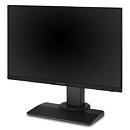Tuesday, July 27th 2021

ViewSonic Releases Blur Busters Approved XG2431 240Hz Gaming Monitor
ViewSonic Corp., a leading global provider of display solutions, announces that the latest gaming monitor, the XG2431, has started shipping. The ultra-sleek 24" display is equipped with an IPS panel that deliver vibrant visuals with an ultra-fast 1 ms response. Approved by industry-renowned Blur Busters* for its motion blur reduction, it gives players the power to compete alongside the pros in the highest levels of First-Person Shooter (FPS), Multiplayer Online Battle Arena (MOBA), and Real-Time Strategy (RTS) genres.
With native Full HD 1080p resolution and 240 Hz refresh rate, professional gamers can gain an edge. The sleek borderless design and wide viewing angles ensure that the XG2431 is ideal for multi-display gaming setups with minimal frame distraction, making it perfect for gaming arenas and tournament play. The ViewSonic XG2431 features AMD FreeSync Premium technology, which synchronizes the output of the GPU graphics card and monitor to eliminate screen tearing and provide smoother frame rates. This 24-inch monitor features the perfect combination of speed, control and color. The super smooth 240 Hz refresh rate allows games to run at an ultra-fast framerate for superior performance, while the 1 ms response time ensures faster and more precise gameplay."The XG2431 gaming monitor is the latest monitor engineered specifically for the hard-core gamer," said Ray Hedrick, product manager at ViewSonic. "We loaded the monitor with features and technologies that can keep up with high-end graphics cards and CPUs and make the players ready for any type of game, whether at home streaming or during a competition."
The XG2431 comes with the company's exclusive ViewMode presets, which offer the user a number of customizable gaming modes, including FPS, RTS and MOBA game settings. Connectivity options include HDMI, USB, and DisplayPort for external devices and accessories, and support for laptops, PCs and Macs.
XG2431 Gaming Monitor
With native Full HD 1080p resolution and 240 Hz refresh rate, professional gamers can gain an edge. The sleek borderless design and wide viewing angles ensure that the XG2431 is ideal for multi-display gaming setups with minimal frame distraction, making it perfect for gaming arenas and tournament play. The ViewSonic XG2431 features AMD FreeSync Premium technology, which synchronizes the output of the GPU graphics card and monitor to eliminate screen tearing and provide smoother frame rates. This 24-inch monitor features the perfect combination of speed, control and color. The super smooth 240 Hz refresh rate allows games to run at an ultra-fast framerate for superior performance, while the 1 ms response time ensures faster and more precise gameplay."The XG2431 gaming monitor is the latest monitor engineered specifically for the hard-core gamer," said Ray Hedrick, product manager at ViewSonic. "We loaded the monitor with features and technologies that can keep up with high-end graphics cards and CPUs and make the players ready for any type of game, whether at home streaming or during a competition."
The XG2431 comes with the company's exclusive ViewMode presets, which offer the user a number of customizable gaming modes, including FPS, RTS and MOBA game settings. Connectivity options include HDMI, USB, and DisplayPort for external devices and accessories, and support for laptops, PCs and Macs.
XG2431 Gaming Monitor
- 24-inch gaming monitor with native 1080p (1920x1080) resolution
- 240 Hz refresh rate; ultra-fast 1 ms (MPRT) response time
- AMD FreeSync Premium technology; Blur Busters approved; Exclusive PureXP technology
- VESA HDR400 Certified
- Connectivity includes: HDMI 1.4, DisplayPort, USB-A/B and Audio-Out
- Available now for an estimated street price of $349.99



21 Comments on ViewSonic Releases Blur Busters Approved XG2431 240Hz Gaming Monitor
Not bad,
too bad there are no240Hz monitors with native 8-bit / 8-bit+FRC. Nowadays with HDR it is becoming more important, I believe you need 8-bit+FRC for DisplayHDR500/600+. It's nice to see the market move to higher brightness displays, <250cd/m2 displays were really annoying in a bright office! Still, gaming monitors with 120Hz used to have trash colours, it's nice that you don't have to make that sacrifice anymoredisplaysolutions.samsung.com/monitor/detail/1642/C27G75T
Or this one
www.dell.com/en-us/shop/alienware-27-gaming-monitor-aw2721d/apd/210-axsw/monitors-monitor-accessories
Or even this one
www.acer.com/ac/en/US/content/predator-model/UM.JX3AA.X01
Before integer scaling on modern graphics cards came along, it was sometimes possible for it to be switched off if the signal was just right, perhaps a bit non-standard, proving that the hardware did support not doing this extra work. In fact, I'd like to know exactly how the AA is turned off with modern cards. I suspect that maybe the monitor is actually receiving a native resolution signal from the card, with the card scaling the desired, lower resolution, without AA to the native resolution.
And finally, why the hell can't older cards do this? I so no technical reason and suspect that it's just marketing to entice users to upgrade.
At least AMD supports it with their 7000 series and later! That's a late 2011 / early 2012 GPU.
I genuinely don't know, are there many monitors with integer scaling mode?
the 1440 238hz was stable? UFO tests showed it was accurate too?
that sounds insane if true... what model did you buy? are you using toastyx cru? or no tweaks at all? just changing the rez in graphics control panel?
Certainly no concrete testing at this point, but fact it would post a signal at all was unexpected and impressive enough to me. At that point it was hard to resist seeing just how far it would go and what else it would do. It's shockingly flexible from what I've seen at least. It's defiantly a bit more sharp at the panel's native resolution. As for the 4K I just tested it and it worked. It even displays it in the monitor menu along with the Hz. It came with like 3ft DP 1.4 cable so maybe the length being shorter helped with the DP 1.4.None that I'm aware of:fear:don't jinx it though...or just blame New World for it.
255Hz 2341 x 1317 @255Hz
Go to www.testufo.com/ghosting
set PPS to 960 if its not already
1; take a VIDEO with a shutter setting that captures 4 frames of your refresh rate (1/60 for 240hz etc.)
2; FOLLOW the UFO with your camera (IN A VIDEO) so the dots lines up to straight | | | | lines
3; Export the frame that looks closest to IRL
Also follow the instructions from here: www.testufo.com/frameskipping because im 99.999999% sure youre frameskipping.
As for the XG2431, Viewsonic apparently only thinks the US exists, everyone else can go pound dirt. :\
blurbusters.com/blur-busters-strobe-utility-download-for-now-shipping-viewsonic-xg2431-240hz-23-8-ips-monitor/
Tested it a bit further and settled on reducing 1Hz lower to 157Hz and it looks and feels better. I'm not even disappointed that I had to reduce the refresh rate from 165Hz native to 157Hz with how much better it both looks and feels. The display clarity just seems a touch nicer over native and the input lag feels much smoother.